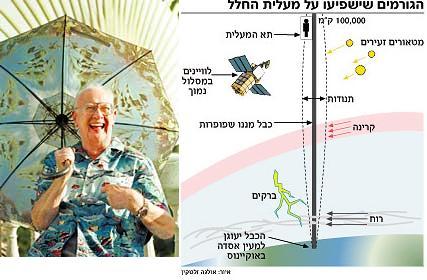Space / Will Arthur C. Clarke's vision of a space elevator come true by 2018
Yuval Dror, Haaretz, voila!

Arthur C. Clarke. "no kidding"
Direct link to this page: https://www.hayadan.org.il/spacelift181003.html
Decades after the science fiction writer Arthur C. Clarke wrote a book in which he mentioned an elevator that starts on the ground and ends in space, scientists at the Los Alamos Laboratory in the USA claim that the time has come to realize the idea. "The first country to build the space elevator will rule space," said the project manager at the laboratory, Bruce Laubscher, in an interview with the CBS network, "I believe that and I think that the Los Alamos laboratory should be involved in the realization of the vision." Clark did predict that such an elevator would be built in 2142, but at least one American company, Liftport, has already begun preparing for construction, which is scheduled to be completed on April 12, 2018.
One of the reasons the scientists returned to the topic, which seems imaginary on the surface, is the high cost of launching space shuttles and the many risks involved in launching and returning the shuttle.
Although the construction cost of the space elevator is expected to amount to several billion dollars, in the long term it will be able to reduce the cost of launching cargo into space from $15 per kilogram to $50.
The infrastructure that will make it possible to send cargo and people into space is seemingly simple - a cable that will be stretched from the earth to a height of 100 thousand kilometers, or about 32 million floors. The cable, which is less than one meter in diameter, is supposed to be constructed of the strongest material known today: nanotubes (very tiny tubes) made of carbon. Elevators will be connected to the cable that will carry people and cargo weighing five tons and will be powered by solar energy. The climbing time to the maximum height is about a week, but it will be possible to release the loads at any height that is required. According to the plan, the cable will be brought into space by a satellite, which will chain it back to Earth, where it will be anchored to a facility similar to an oil drilling rig in the ocean.
Although the project ignites the imagination, the road to its implementation is long. Almost all problems are related in one way or another to that special cable. First, a cable of the requested type is only in the first stages of development. While the project requires a cable 100 thousand kilometers long, the length of the carbon cables available to the scientists does not exceed a few tens of centimeters.
However, the problems do not end here either. The environment where the cable will be stretched is not considered particularly friendly. The cable of the space elevator will be affected by strong winds, lightning, space debris (old satellites), satellites from fly-downs, electromagnetic fields, radiation and more. In addition, there is a fear that if the cable swings too much, it will be impossible to load the loads on it. Some argue that a cable of this type would also be a sought-after target among terrorist organizations.
To prove the seriousness of their intentions, researchers from the USA gathered last month in the state of New Mexico and discussed the idea of the space elevator. The conference was opened by Arthur C. Clark himself. "I think this is the way to reach space," said the 86-year-old author in a satellite broadcast from his home. "The economic calculations show that this is a fantastic idea. I believe that the elevator will be built 10 years after everyone stops laughing. I think they're not laughing now."
For the report of the "Hidan" from that symposium on the day of its convening
Spacecraft expert - the next generation
https://www.hayadan.org.il/BuildaGate4/general2/data_card.php?Cat=~~~661995637~~~9&SiteName=hayadan
